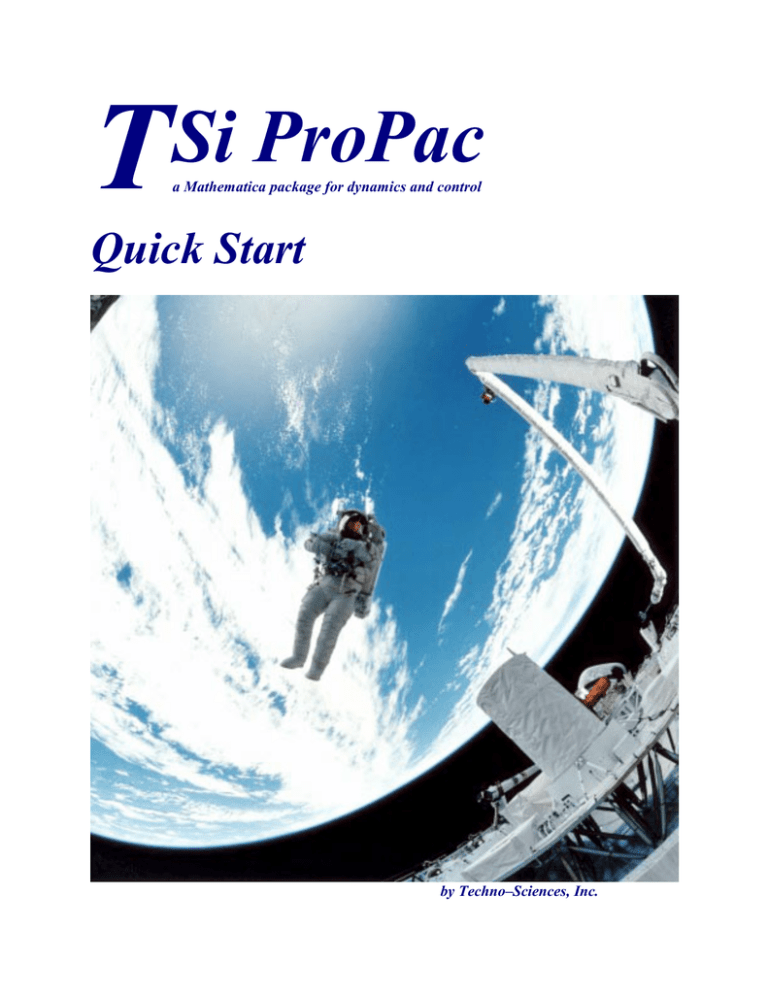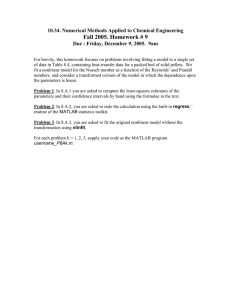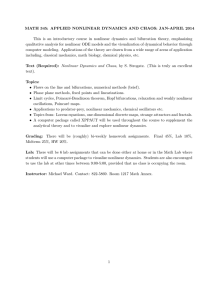
T
Si ProPac
a Mathematica package for dynamics and control
Quick Start
by Techno–Sciences, Inc.
TSi ProPac
Software and documentation by
Techno-Sciences, Inc.
Techno–Sciences Incorporated
10001 Derekwood Lane, Suite 204
Lanham, MD 20706
(301) 577–6000
info@technosci.com
www.technosci.com
Copyright 1994, 1996 & 1997, 1999 Techno–Sciences, Incorporated
All Rights Reserved
Table of Contents
1. INTRODUCTION............................................................................................................................1
INSTALLATION .................................................................................................................................... 2
2.
PACKAGE CONTENT ...............................................................................................................3
OVERVIEW .......................................................................................................................................... 3
MODELING .......................................................................................................................................... 4
CONTROL ............................................................................................................................................ 5
INTERFACING WITH MATLAB............................................................................................................. 5
3.
FOR USERS OF EARLIER VERSIONS..................................................................................10
4. REFERENCES...............................................................................................................................12
1. Introduction
TSi
ProPac is a Mathematica package that integrates and expands the
capabilities of Techno-Sciences’ TSi Dynamics and TSi Controls. It provides
a comprehensive set of symbolic computing tools for modeling multibody mechanical
systems as well as for linear and nonlinear control system design and analysis. New
features include:
•
the capability to model systems with nondifferentiable nonlinearities, such as static
friction and backlash,
•
the capability to compute equilibrium surfaces, to generate parameter-dependent linear
families, and to construct parameter-dependent zero dynamics,
•
tools for constructing nonlinear observers.
•
tools for variable structure control system design.
In addition, ProPac includes a number of algorithm modifications designed to improve
performance, particularly for large problems. Users of earlier versions should be aware
that many functions can now be called with a simplified syntax that makes them easier to
use.
TSi ProPac includes a revised and expanded set of tutorial and application notebooks.
These include Dynamics and Controls which introduce the basic modeling and control
tools available in ProPac. For more information, notebooks and other documents visit our
web site: www.technosci.com.
Using ProPac requires version 2, 3 or 4 of Mathematica. That is all that is required to
develop the equations of motion, for conducting numerical simulations within
Mathematica, and building the C source code required for simulations in SIMULINK. Use
of the latter requires MATLAB/SIMULINK and a C compiler as recommended by the
MathWorks for compiling MEX–files on the user’s platform.
Installation
To install ProPac, follow the two step procedure:
Step 1:
Put the entire ProPac directory in the Mathematica’s AddOns/Applications
directory. For the PC the full path is
C:\Program Files\Wolfram Research\Mathematica\4.0\AddOns\Applications\
Step 2:
Start Mathematica 4.0 and rebuild the Help index: From the main menu choose:
Help ⇒ Rebuild Help Index …
Once this is done, on line help is available. In the Help Browser select Add-ons and
then TSi ProPac.
The Mex folder contains 3 C-source files that are need to be included when compiling
MATLAB/SIMULINK MEX files. These may stored in any convenient location, but must
be available at the time of compilation.
2. Package Content
Overview
TSi
ProPac consists of seven packages: Dynamics, ControlL, ControlN,
GeoTools, MEXTools, NDTools, and VSCTools. Once ProPac is loaded all
of the functions in these packages are available for use and the appropriate packages will
be automatically loaded as required. In general, a user does not have to be concerned
about loading any particular package. To load ProPac in Mathematica 3.0 or 4.0 simply
enter <<ProPac`, and in Mathematica 2.2 enter <<ProPac`Master`.
Dynamics contains the model building functions and ControlL and ControlN the linear
and nonlinear control analysis functions, respectively. GeoTools includes basic functions
used in differential geometry calculations. NDTools contains supporting functions for
working with nondifferentiable nonlinearities and VSCTools contains functions for
variable structure control. MEXTools includes functions for creating C-code files for both
models and controllers that compile as S-functions for use with MATLAB/SIMULINK.
The following paragraphs contain a brief summary of the available functions. More
details and numerous examples can be found in the help browser and in the notebooks.
The notebooks Dynamics.nb and Controls.nb are tutorials that illustrate the basic data
structures and tools.
Modeling
ProPac contains a comprehensive set of tools for assembling models of multibody
mechanical systems. A few of these are listed in Table 1. The model building process has
two distinctive features. First, the joints are defined in terms of their primitive action
parameters from which all the required kinematic relations are derived. Thus, a user can
contrive unusual joint configurations and is not restricted to a predefined set of standard
joints. Second, the equations are formulated in Poincaré’s form of Lagrange’s equations1
that admits the standard Lagrange equations as a special case [1, 3, 7]. However,
Poincaré’s form allows the exploitation of quasi–velocities which can greatly simplify the
equations of motion.
The explicit models generated are of the form:
Kinematics:
q = V (q ) p
Dynamics:
M (q ) p + C (q , p) p + F (q , p, u) = 0
where q is a vector of configuration coordinates, p is a vector of quasi–velocities and u is
a vector of exogenous inputs. They may be subjected to further symbolic processing for
purposes such as nonlinear model reduction, nonlinear control system design or
linearization. They may also be used for simulation or other numerical analysis procedures.
To facilitate the latter applications, the package provides a direct interface to
MATLAB/SIMULINK. In view of the complexity of models incorporating fully nonlinear
kinematics, the C–code generated for this purpose, is organized to minimize the required
numerical calculations.
To build a model, a user supplies defining data for individual joints and bodies, and the
system structure. With this data, functions are available that can compute the kinetic
energy function and inertia matrix as well as the gravitational potential energy function. It
can also compute the strain potential energy and dissipation functions associated with
deformations of flexible bodies. Various kinematic quantities can be obtained as well, e.g.,
end–effector configuration as a function of joint and deformation parameters. To complete
a dynamic analysis, the user must supply the remaining parts of the potential energy
1
Poincaré’s equations [1-3] are also referred to as Lagrange’s equations in quasi-coordinates [4, 5] or
pseudo-coordinates [6].
function and definitions for any generalized forces. Functions are available to assist in
developing these quantities.
Control
The control software can be grouped into three general categories: linear control,
nonlinear control and geometric tools. Software tools are provided for the manipulation of
linear controls systems in state space or frequency domain forms. Functions for the
conversion of one form of model to the other are also included. Examples of the functions
provided are listed in Table 2 and Table 3.
ProPac includes tools required to apply modern geometric methods of control system
design to nonlinear affine systems [8, 9]. These methods play an important role in adaptive
control system design [9-12] and variable structure control as well [13, 14]. Typical
functions are given in Table 4. Table 5 illustrates functions for adaptive control system
design and Table 6 shows the basic tools for variable structure control systems. Examples
of geometric functions that support the control analysis constructions are given in Table 7.
Interfacing with MATLAB
MATLAB/SIMULINK are widely used tools for dynamic system simulation and control
system analysis and design. Consequently, it is often convenient to implement the results
of symbolic analysis in that environment. ProPac provides convenient interface tools. The
function MatlabForm allows exporting numerical matrices constructed in Mathematica in
a form readable by MATLAB. In addition, functions are included that construct
‘optimized’ C-source code files that compile as ‘MEX files’ defining S-functions for use as
modules in the SIMULINK block diagram environment.
Separate functions are used to define models and controllers as illustrated in Figure 1.
Models are defined in terms of Poincaré’s equations (see above) and controllers are
defined in terms of state descriptions:
x = f ( x, u)
y = h( x , u)
Controller modules do not require any MATLAB resources so they can be used for real
time implementation via MATLAB’s Real Time Workshop.
Control Analysis
& Design
Model Building
Mathematica
Control S-Function
Source Code (C)
Model S-Function
Source Code (C)
System Model
Controller
MATLAB/
SIMULINK
Figure 1. Interfacing with MATLAB/SIMULINK.
Table 1. Multibody Dynamics
Function Name
Operation
Joints
returns all of the kinematic quantities
corresponding to a list of joint definitions
TreeInertia
computes the inertia matrix of a multibody
system in a tree structure containing flexible
and rigid bodies
EndEffector
returns the Euclidean Configuration Matrix
of a body fixed frame at a specified node
NodeVelocity
returns the (6 dim) spatial velocity vector of
a body fixed frame at a specified node
GeneralizedForce
computes the generalized force at specified
node in terms of generalized coordinates
KinematicReplacements
sets up temporary replacement rules for
repeated groups of expressions to simplify
kinematic quantities
CreateModel
builds the kinematic and dynamic equations
for tree structures
DifferentialConstraints
adds differential constraints to a tree
configuration
AlgebraicConstraints
adds algebraic constraints to a tree
configuration
Table 2. Linear Systems: State Space
Function Name
Operation
ControllablePair/ ObservablePair
tests for controllability and observability
ControllabilityMatrix
returns the controllability or observability matrices,
respectively
ObservabilityMatrix
PolePlace
state feedback pole placement based on Ackermann’s
formula with options
DecouplingConrol
state feedback and coordinate transformation that
decouples input-output map
RelativeDegree
computes the vector relative degree
LQR, LQE
compute optimal quadratic regulator and estimator
parameters
Table 3. Linear Systems: Frequency Domain
Function Name
Operation
LeastCommonDenominator finds the least common denominator of
the elements of a proper, rational G(s)
Poles
finds the roots of the least common
denominator
LaurentSeries
computes the Laurent series up to
specified order
AssociatedHankelMatrix
computes the Hankel matrix associated
with Laurent expansion of G(s)
McMillanDegree
computes the degree of the minimal
realization of G(s)
ControllableRealization
compute, respectively, the controllable
and observable realizations of a transfer
function
ObservableRealization
Table 4. Nonlinear systems: Geometric Control
Function Name
Operation
VectorRelativeOrder
computes the relative degree vector
DecouplingMatrix
computes the decoupling matrix
IOLinearize
computes the linearizing control
NormalCoordinates
computes the partial state transformation,
LocalZeroDynamics
computes the local form of the zero dynamics
StructureAlgorithm
computes the parameters of an inverse system
DynamicExtension
applies dynamic extension as a remedy for
singular decoupling matrix
Table 5. Nonlinear systems: Adaptive Control
Function Name
AdaptiveRegulator
Operation
generates an adaptive regulator for a class of linearizable
systems
AdaptiveBackstepRegulator computes an adaptive regulator by backstepping for SISO
systems in PSFF form
AdaptiveTracking
computes an adaptive tracking controller
PSFFCond
tests a system to determine if it is reducible to PSFF form
PSFFSolve
transforms a system to PSFF form if possible
Table 6 Nonlinear systems: Variable Structure Control
Function Name
Operation
SlidingSurface
generates the sliding (switching) surface for
feedback linearizable nonlinear systems
SwitchingControl
computes the switching functions – allows the
inclusion of smoothing and moderating functions
Table 7. Nonlinear systems: Geometric Tools
Function Name
Operation
LieBracket
computes the Lie bracket of a given pair of
vector fields
Ad
computes the iterated Lie bracket of specified
order of a pair of vector fields
Involutive
tests a set of vector fields to determine if it is
involutive
Span
generates a set of basis vector fields for a given
set of vector fields
FlowComposition
generates a composite function from a given set
of flows
ParametricManifold
computes a parametric representation for an
imbedded manifold
StateTransformation
transforms nonlinear dynamic models in various
forms
3. For Users of
Earlier Versions
Users of earlier versions of TSi Dynamics and TSi Controls should be aware that some
function names have been changed. This has been done in order to conform to WRI
naming conventions and/or to enhance clarity. Table 8 and Table 9 summarize the function
name changes.
Table 8 Control Functions
Old
New
AdaptBackstepReg
AdaptiveBackstepRegulator
AlgRiccatiEq
AlgebraicRiccatiEquation
BodePlot
Bode
Controllable
ControllablePair
H2H1andH2
HToH1AndH2
H2NandM
HToNAndM
HankelMat/HankelMatrix
AssociatedHankelMatrix
IverseTrans
InverseTransformation
LocalInverseTrans
LocalInverseTransformation
MatRank
MatrixRank
NyquistPlot
Nyquist
Observable
ObservablePair
PartialTransSystem
PartialTransformSystem
RootLocusPlot
RootLocus
TransSystem
TransformSystem
Table 9 Dynamics Functions
Old
New
AlgConstrainedSys
AlgebraicConstraints
Atil2a
ATildaToA
Atilda
AToATilda
Cmat
CMatrix
DiffConstrainedSys
DifferentialConstraints
EndEffectorVelocity
NodeVelocity
GamaKin
SimpleJointKinematics
GamCmpnd
CompoundJointKinematics
HCmpnd
CompoundJointMap
Leuler
RotationMatrixEuler
Lrot
JointRotation
PoincareFunc
PoincareFunctionCombined
PoincareFuncSim
PoincareFunction
PoinCoef
PoincareCoefficient
RotMat2Euler
RotationMatrixToEuler
Rtran
JointTranslation
Xeuler
ConfigurationMatrixEuler
XXCmpd
CompoundJointConfiguration
XXeuc
SimpleJointConfiguration
4. References
[1] V. I. Arnold, V. V. Kozlov, and A. I. Neishtadt, Mathematical Aspects of Classical and Celestial
Mechanics, vol. 3. Heidelberg: Springer–Verlag, 1988.
[2] N. G. Chetaev, “On the Equations of Poincaré,” PMM (Applied Mathematics and Mechanics), pp.
253–262, 1941.
[3] N. G. Chetaev, Theoretical Mechanics. New York: Springer–Verlag, 1989.
[4] L. Meirovitch, Methods of Analytical Dynamics. New York: McGraw–Hill, Inc., 1970.
[5] J. I. Neimark and N. A. Fufaev, Dynamics of Nonholonomic Systems, vol. 33. Providence: American
Mathematical Society, 1972.
[6] F. Gantmacher, Lectures in Analytical Mechanics, English Translation ed. Moscow: Mir, 1975.
[7] H. G. Kwatny and G. L. Blankenship, “Symbolic Construction of Models for Multibody Dynamics,”
IEEE Transactions on Robotics and Automation, vol. 11, pp. 271-281, 1995.
[8] A. Isidori, Nonlinear Control Systems, 3 ed. London: Springer-Verlag, 1995.
[9] H. Nijmeijer and H. J. van der Schaft, Nonlinear Dynamical Control Systems. New York: Springer–
Verlag, 1990.
[10] G. L. Blankenship, R. Ghanadan, H. G. Kwatny, C. LaVigna, and V. Polyakov, “Integrated tools for
Modeling and Design of Controlled Nonlinear Systems,” IEEE Control Systems, vol. 15, pp. 65-79,
1995.
[11] I. Kanellakapoulos, P. V. Kokotovic, and A. S. Morse, “Systematic design of Adaptive Controllers for
Feedback Linearizable Systems,” IEEE Transactions on Automatic Control, vol. AC–36, pp. 1241–
1253, 1991.
[12] M. Krstic, I. Kanellakopoulos, and P. V. Kokotovic, “Adaptive Nonlinear Control Without
Overparameterization,” Systems and Control Letters, vol. 19, pp. 177-185, 1992.
[13] H. G. Kwatny and H. Kim, “Variable Structure Regulation of Partially Linearizable Dynamics,”
Systems & Control Letters, vol. 15, pp. 67–80, 1990.
[14] H. G. Kwatny and G. L. Blankenship, “Symbolic Tools for Variable Structure Control System
Design: The Zero Dynamics,” presented at IFAC Symposium on Robust Control via Variable
Structure and Lyapunov Techniques, Benevento, Italy, 1994.





